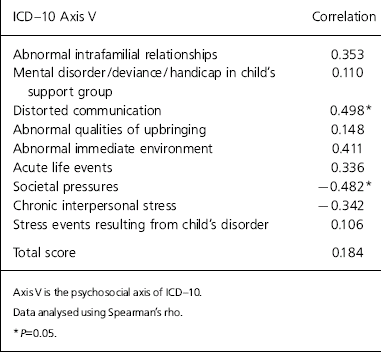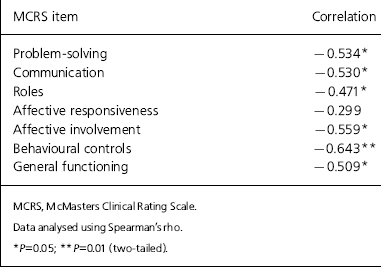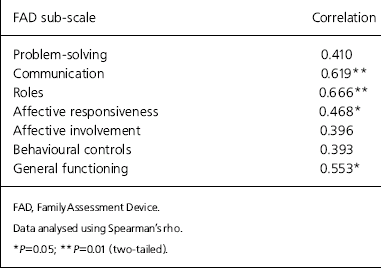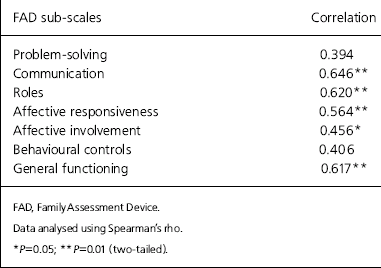The Health of the Nation Outcome Scale (HoNOS) was developed primarily for use with adult psychiatric patients (Reference Wing, Beevor and CurtisWing et al, 1996). Subsequently, similar scales for children and adolescents with psychiatric disorders (HoNOSCA) were developed (Reference Gowers, Harrington and WhittonGowers et al, 1999) and are brief, simple and clinically acceptable for use in everyday practice. The scales cover a wide range of problem areas and include a scale on ‘ problems with family life and relationships’. They are reported to be both psychometrically sound and sensitive to change over time and to show satisfactory reliability and validity (Reference Gowers, Harrington and WhittonGowers et al, 1999). However, HoNOSCA has been compared with the Children's Global Assessment Scale (CGAS) where correlations were found to vary from moderate to modest depending on the sub-scale (Reference Yates, Garralda and HigginsonYates et al, 1999). Low correlations were found between HoNOSCA (total score) and the Strengths and Difficulties Questionnaire and a measure of self-esteem.
The validity and reliability of some sub-scales is clearly in question. It is not clear from the literature exactly what aspects of family functioning and experience the sub-scale of Family Life and Relationships actually measures or against what gold standards this subscale has been correlated - if at all.
The aim of this study was to investigate the concurrent validity of the Family Life and Relationships sub-scale of HoNOSCA by comparing it with two well-established measures of family functioning and a measure of psychosocial functioning that has a strong family emphasis.
Method
Procedure
The authors provided workshops on HoNOSCA using the training manual and accompanying video developed by the Royal College of Psychiatrists’ research unit. Clinicians also received a further 2-day intensive training in the use of Axis V of ICD-10 and the application of the glossary of terms (Reference Gowers, Harrington and WhittonGowers et al, 1998).
Twenty families agreed to participate in the study. Clinicians seeing the families rated them using HoNOSCA and Axis V of ICD-10 (Associated Abnormal Psychosocial Situations). Each family member completed a Demographic Family Information Sheet, a Child Behavior Checklist (CBCL), and the Family Assessment Device (FAD). Trained family therapists then interviewed the families using the McMasters Structured Interview of Family Functioning (McSIFF, Reference Bishop, Epstein and KeitnerBishop et al, 1980). This interview provided information that enabled the family to be rated on the McMasters Clinical Rating Scale (MCRS).
Measures
Health of the Nation Scales for Children and Adolescents (HoNOSCA)
This is a clinician-rated scale consisting of 13 items plus two option scales. The Trainer's Guide for sub-scale 12 (Problems with Family Life and Relationships) instructs clinicians to use this item to refer to relationships with parents and siblings in the family home (or foster or residential home). In addition:
parental personality problems, mental illnesses and marital difficulties should only be rated here if they have an effect on the child, though this will usually be the case. Problems associated with physical, emotional or sexual abuse should be included but this scale is not intended to address abusive or neglectful features alone. Difficulties arising from over involvement and overprotection should also be included, as well as difficulties arising from family re-organisation as a result of relocation or bereavement (Reference Gowers, Harrington and WhittonGowers et al, 1997).
In summary, this scale is purported to measure a hybrid of family functioning indices (relationships, overinvolvement, etc.) and life events (abuse, bereavement, etc.).
McMasters Structured Interview of Family Functioning
This structured interview (Reference Bishop, Epstein and KeitnerBishop et al, 1980) was developed so that researchers and clinicians could conduct valid and reliable family interviews. The interview addresses six areas of family functioning: roles, behavioural controls, problem-solving, communication, affective responsiveness and affective involvement. The dimensions of the McSIFF are based on the McMasters model of family functioning.
McMasters Clinical Rating Scale
This is a seven-item scale that rates each of the six dimensions of the McMasters model. It also gives an overall health/pathology rating. It was designed for use either by a rater who observes an in-depth family interview or by a researcher or clinician who carries out a structured interview (i.e. the McSIFF). The scale measures family functioning across a continuum from very dysfunctional to superior functioning on a seven-point Likert scale. Concurrent validity with the Family Assessment Device (FAD) has been demonstrated (Reference FristadFristad, 1989), as has discriminant validity, interrater reliability and test-retest reliability over a 3-month period (Reference Keitner, Ryan and MillerKeitner et al, 1992).
Family Assessment Device
The FAD is a paper-and-pencil questionnaire, which can be filled out by all family members over the age of 12. It yields seven scales: the six domains of family functioning (identified in the McMaster Model) and a General Family Functioning Scale that assesses the overall health/pathology of the family. Epstein & Bishop (Reference Epstein and Bishop1981) suggest that the FAD is both a reliable and valid instrument.
Child Behavior Checklist
The CBCL is a well-recognised inventory of emotional and behavioural problems designed for children aged 4–18 years of age. It is considered to be both a valid and reliable instrument and has been standardised (Reference AchenbachAchenbach, 1991).
ICD-10 Axis V
The psychosocial axis (Axis V) of the World Health Organization (1996) Multi-Axial Classification of Child and Adolescent Psychiatric Disorders lists nine abnormal psychosocial situations associated with psychopathology: abnormal intrafamilial relationships; mental disorder, deviance or handicap in the child's primary support group; inadequate or distorted intrafamilial communication; abnormal qualities of upbringing; abnormal immediate environment; acute life events; societal stressors; chronic interpersonal stress associated with school/work; and stressful events/situations resulting from the child's disorder. A semi-structured interview, the Interview Schedule for Children, has been developed as a companion to Axis V - however, its administration takes about 60 min (Reference Van Goor-Lambo, Orley and PoustkaVan Goor-Lambo et al, 1990). We developed a simple tick-box sheet in line with the methodologies for application of the Axis V scheme proposed by Van Goor-Lambo et al (Reference Van Goor-Lambo, Orley and Poustka1990), to be filled in by clinicians who had already fully assessed the family. Coding was performed strictly in terms of whether the child's situation fulfilled the guidelines for the category, irrespective of whether such psychosocial circumstances are thought to be causal of psychiatric disorder. Codings from the research criteria of ICD-10, Axis V were employed: a score of 2 indicated the situation definitely applied during the specified period (see below) and was of a type and severity that definitely met the diagnostic guidelines of the Axis V glossary; a score of 1 indicated that the situation definitely applied during the specified time period, was of a type that fulfilled the category guidelines, but was of a severity that fell short of the specified criteria in spite of being judged abnormal and potentially significant; a score of zero indicated that the psychosocial situation with respect to the future was broadly within the normal range (including minor abnormalities of little clinical significance). No scores were given when criteria could not have applied to the child given their particular circumstances or where insufficient information was available to make the coding. The coding time frame was based on the child's lifetime, on the basis of evidence that the situation or life event had played a role in causative processes.
We also generated a total score of adversity by summing all scores across the nine sub-scales.
Data analysis
The data were analysed using the Statistical Package for the Social Sciences (SPSS) version 10, for Windows. Non-parametric correlation coefficients between the variables were computed using Spearman's rho.
Results
The mean age of mothers of referred children was 38.6 years and the mean age of fathers was 41 years. The mean age of referred children was 10.2 years. Half of the participants were married, a quarter separated and a tenth widowed. Of the 20 index children, 15 (75%) were boys and 5 (25%) were girls. On the CBCL, 5 children (25%) were within the normal range for Total Problem T scores whereas 2 (10%) were in the borderline range and 13 (65%) were within the clinical range. For the internalising T scores, 5 children (25%) were within the normal range, 2 (10%) were within the borderline range and 13 (65%) were within the clinical range. For the externalising T scores, 8 children (40%) were within the normal range, 3 (15%) were in the borderline range and 9 (45%) were within the clinical range.
HoNOSCA and Axis V
Significant correlations were found between HoNOSCA (12) and the Axis V sub-scales Inadequate or distorted intrafamilial communication (r=0.498, P<0.05) and Societal pressure (r=0.482, P<0.05). There were no other correlations between HoNOSCA and any of the other sub-scales of Axis V or of the total score for Axis V (Table 1).
Table 1. Correlations between HoNOSCA Family Life and Relationships and ICD—10 Axis V

| ICD—10 Axis V | Correlation |
|---|---|
| Abnormal intrafamilial relationships | 0.353 |
| Mental disorder/deviance/handicap in child's support group | 0.110 |
| Distorted communication | 0.498* |
| Abnormal qualities of upbringing | 0.148 |
| Abnormal immediate environment | 0.411 |
| Acute life events | 0.336 |
| Societal pressures | -0.482* |
| Chronic interpersonal stress | -0.342 |
| Stress events resulting from child's disorder | 0.106 |
| Total score | 0.184 |
HoNOSCA and MCRS
There were significant correlations between HoNOSCA (12) and all the MCRS sub-scales besides affective responsiveness: problem-solving (r=-0.534, P<0.05); roles (r=-0.471, P<0.05); affective involvement (r=-0.559, P<0.05); communication (r=-0.530, P<0.05); behavioural controls (r=-0.643, P<0.01); and general functioning (r=-0.509, P<0.05) (Table 2). The negative scores between the MCRS and HoNOSCA relate to how the MCRS scores: lower scores in the MCRS indicate that the family have more marked difficulties whereas higher scores indicate overall healthy family functioning.
Table 2. Correlations between HoNOSCA Family Life and Relationships and MCRS

| MCRS item | Correlation |
|---|---|
| Problem-solving | -0.534* |
| Communication | -0.530* |
| Roles | -0.471* |
| Affective responsiveness | -0.299 |
| Affective involvement | -0.559* |
| Behavioural controls | -0.643** |
| General functioning | -0.509* |
HoNOSCA and FAD
The HoNOSCA (12) was significantly correlated with the mean family scores for the following FAD sub-scales: general functioning (r=0.553, P<0.05); affective responsiveness (r=0.468, P<0.05); roles (r=0.666, P<0.01); and communication (r=0.619, P<0.01) (Table 3). HoNOSCA (12) was also significantly correlated with mothers’ scores for the following FAD sub-scales: communication (r=0.646, P<0.01); roles (r=0.620, P<0.01); affective responsiveness (r=0.564, P<0.01); affective involvement (r=0.456, P<0.05); and general functioning (r=0.617, P<0.01) (Table 4).
Table 3. Correlations between HoNOSCA Family Life and Relationships and FAD (mean family ratings)

| FAD sub-scale | Correlation |
|---|---|
| Problem-solving | 0.410 |
| Communication | 0.619** |
| Roles | 0.666** |
| Affective responsiveness | 0.468* |
| Affective involvement | 0.396 |
| Behavioural controls | 0.393 |
| General functioning | 0.553* |
Table 4. Correlations between HoNOSCA Family Life and Relationships and FAD (mothers)

| FAD sub-scales | Correlation |
|---|---|
| Problem-solving | 0.394 |
| Communication | 0.646** |
| Roles | 0.620** |
| Affective responsiveness | 0.564** |
| Affective involvement | 0.456* |
| Behavioural controls | 0.406 |
| General functioning | 0.617** |
Discussion
The principal aim of this study was to establish whether a relationship exists between HoNOSCA sub-scale 12 and gold standard measures of family functioning and family life events (both clinician- and family-rated). Also, we have attempted to clarify what precise aspects of family functioning and family life events the scale might be measuring. We have taken the FAD and the MCRS to be measures of family functioning and Axis V to be a measure primarily of life events, although it does include a measure of family relationships.
The results indicate that HoNOSCA (12) correlates well with the FAD completed by the families and the MCRS completed by the researchers. There was little, if any, relationship between HoNOSCA (12) and Axis V. In other words, when applying HoNOSCA (12) to families, it appears that we are principally measuring aspects of family functioning in line with the McMasters’ theoretical model and not the life events and family psychosocial adversities that it alludes to in its definition. The interpretation of this finding is difficult and we believe this is because of a lack of clarity in the definition of the HoNOSCA (12) sub-scale itself. The description of HoNOSCA (12) in the Trainer's Guide indicates that it spans both family functioning and life events; however, it is clear that in coding, some life events (parental mental illness) should be subordinated to the former and considered only for their effect upon the child. The Trainer's Guide is ambiguous regarding rating abuse: ‘it should be included but this scale is not intended to address abusive or neglectful factors alone’ (Reference Gowers, Harrington and WhittonGowers et al, 1997). In the separate Glossary for HoNOSCA Score Sheet it is clearly indicated that sexual and/or physical abuse can be included on its own as a life event (Reference Gowers, Harrington and WhittonGowers et al, 1998). In other words, it assumes that its occurrence within the family coexists with relationship problems.
If our clinical raters have interpreted HoNOSCA (12) as requiring discrimination between life events as cold historical facts (to be excluded) and life events according to how they impact upon the child and their relationships within the family, then the lack of correlation between HoNOSCA (12) and Axis V indicates of course a correct use of HoNOSCA according to the Trainer's Guide but not the Glossary.
There might be other explanations for this finding. Axis V is a broad multi-axial framework, which looks at the family's psychosocial situation over a life span (or a specified time frame) whereas HoNOSCA measures the child's symptomatology over a 2-week period.
Also, the lack of a correlation between HoNOSCA and Axis V might be in part a result of the poor reliability of the psychosocial axis when tested in day-to-day practice (Reference Willemse, Van Yperen and RispensWillemse et al, 2003). It might also be owing to different professional groups’ ability within child psychiatry to work with criterion-based classifications. Applying Axis V reliably and validly requires a complex understanding of diagnostic classification; something medical staff clearly have more experience of. This is in contrast to the HoNOSCA which can be used reliably by members of a multidisciplinary team. Further training may be required, especially for ICD-10 Axis V so that all members of the multidisciplinary team are completing assessments in a consistent manner.
There are recognised limitations of this research. The sample size of 20 families is small. Also, there was a time delay between the families’ first appointment with their clinician and the family interview with the researchers. The family may have already changed their individual and family behaviours following the first encounter with the services.
The HoNOSCA promotes a multidisciplinary approach to care and encourages team members to practise from an outcome perspective. HoNOSCA (12) appears to provide a quick and valid assessment of overall family dysfunction, one that corresponds to the theoretical model of McMasters. It can be used in a time-efficient manner as a means to assess whether further more comprehensive family assessment or family therapy is required. Finally, this small study indicates that some revision of the definition of the scale in the Trainer's Guide and the practical use of it in the Glossary is required to bring both into closer harmony.
Declaration of interest
None.







eLetters
No eLetters have been published for this article.